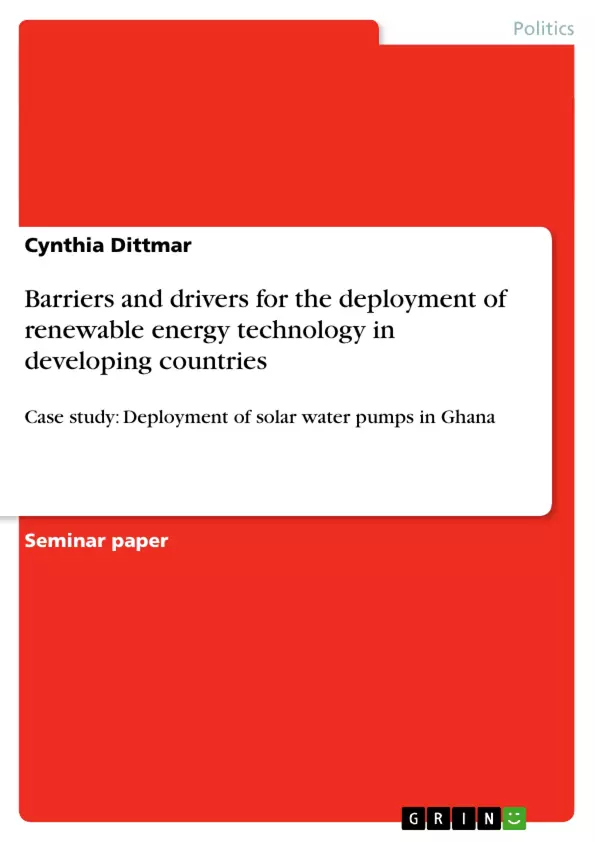Renewable energy technology (RET) are considered as “one of the strong contenders to improve plight” (Painuly 2001: 73) for more than 2 billion people in developing coun-tries who don’t have access to the clean modern energy which is essential to social and economic development (BMZ 2006). RET are increasingly recognised for their contri-bution to development especially in rural areas, increasing health, energy independence and climate change mitigation.
Due to massive technological improvements in recent years, economies of scale in pro-duction and given the absence of market distortions , RET can be cost competitive with conventional energy sources. This counts especially for off-grid RET in rural and remote areas where costs for grid connection are excessively expensive and where 80% of people without access to electricity live. RET become even more competitive if environmental externalities are factored into the market price of competing fuels (Martinot et al. 2002). Despite those advantages, RET in developing and developed countries are only tapped to a small amount of their potential as there are several types of barriers to their deployment (Painuly 2001). While traditional renewable energy sources like bio-mass (i.e. fuel wood, animal wastes and crop residues) provide 30 - 45% of the energy supply in developing countries (up to 90 % in rural Sub-Sahara-Africa) RET produce only about 2 % of the global energy supply, mostly in developed countries (REN21 2005).
This paper aims to identify major drivers and barriers to the deployment of renewable energy technology in developing countries. In chapter two the main drivers for RET, as well as their ability to contribute to development aims and poverty reduction, will be discussed in general, as there are a number of incentives for developing as well as de-veloped countries. Barriers, however, depend more on the particular technology and conditions in countries or regions (Martinot et al. 2002). The second part of this paper will look at a specific case study: The deployment of solar water pumps in Ghana.
[...]
Inhaltsverzeichnis (Table of Contents)
- Introduction
- Drivers for the deployment of RET in developing countries
- Drivers for developing countries
- Drivers for developed countries
- Barriers to the deployment of RET in developing countries
- Case study: Barriers to the deployment of solar water pumps in Ghana
- Energy in Ghana
- Case study: Solar water pumps in Ghana
- Conclusion
Zielsetzung und Themenschwerpunkte (Objectives and Key Themes)
This paper aims to identify the major drivers and barriers to the deployment of renewable energy technology in developing countries. It explores the advantages of RET for both developing and developed countries, highlighting their contribution to economic and social development, particularly in rural areas. The paper focuses on a specific case study: the deployment of solar water pumps in Ghana.
- The importance of renewable energy technology (RET) in improving the lives of people in developing countries.
- The various drivers and barriers to the deployment of RET in developing countries.
- The impact of RET on social and economic development, particularly in rural areas.
- The case study of solar water pumps in Ghana, examining its barriers and challenges.
- The role of international cooperation and support in promoting the adoption of RET in developing countries.
Zusammenfassung der Kapitel (Chapter Summaries)
The paper begins with an introduction that outlines the crucial role of renewable energy technology (RET) in providing energy access to developing countries and improving their social and economic development. It discusses the cost-competitiveness of RET in off-grid applications, especially in rural areas where access to electricity is limited. The paper then explores the different drivers for promoting RET in developing countries, emphasizing their benefits for economic development, poverty reduction, and energy independence. It also analyzes the incentives for developed countries to support RET deployment in the South, focusing on the role of international climate change agreements and economic interests.
Chapter 2 delves into the drivers for RET in developing countries, highlighting their potential to reduce dependency on oil imports, address energy poverty, and contribute to sustainable development. Chapter 3 focuses on the barriers to RET deployment, emphasizing challenges like inadequate infrastructure, limited access to finance, and insufficient technical capacity.
Chapter 4 provides a case study on the deployment of solar water pumps in Ghana, analyzing the specific barriers and challenges faced in this context. It discusses Ghana's energy situation and the potential of solar water pumps to improve water access and agricultural productivity.
Schlüsselwörter (Keywords)
This paper focuses on renewable energy technology (RET), particularly in developing countries. It examines the drivers and barriers to its deployment, including economic development, poverty reduction, energy independence, climate change mitigation, and international cooperation. The paper also explores the role of RET in rural electrification, social and economic development, and its impact on health, time use, and livelihoods. The case study of solar water pumps in Ghana highlights the specific challenges and opportunities of RET deployment in a developing country context.
- Quote paper
- Cynthia Dittmar (Author), 2008, Barriers and drivers for the deployment of renewable energy technology in developing countries, Munich, GRIN Verlag, https://www.grin.com/document/131922



